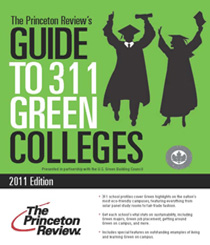When environmentally conscious individuals like you and I look around, we want to see that the organizations that we’re a part of are making the effort to be as green as we are. We like it when our schools construct green buildings and have mandatory recycling. But how do we know that the school we’re going to is as green as we think they are? The Princeton Review publishes a guide of the most eco-friendly, green schools in the country every year around Earth Day.
The Princeton Review’s Guide to 311 Green Colleges ratings are based on data from a 50-question survey of hundreds of administrators about their school’s environmental and sustainability-related commitments and initiatives such as participation in the USGBC’s LEED green building certification program, environmental literacy programs, formal sustainability committees, use of renewable energy resources, and recycling and conservation programs.
The schools selected for the guide received a “green rating” between 60 and 99 – or a score within the 80th percentile or higher among the 703 institutions surveyed.
The list highlights the schools that have been featured a few times as well as some new comers.
Dartmouth College and Sonoma State design eco-friendly buildings and dorms that incorporate natural lighting and help to reduce energy and water use. While schools like Naropa University in Boulder, Colorado, understand that food tastes better when it’s local and organic. They don’t transport produce across the country to get it into their cafes and cafeterias.
Eco-friendly schools like Arizona State University and University of Arkansas-Fayetteville provide free bus passes to bike share and even car share programs so you don’t waste energy driving from here to there.
Many schools have already joined the green movement but if your school isn’t on the list, there are some easy ways to keep yourself green. For starters, you can read Quick Tips: How to Green Your Dorm.
How much do you really know about being green in college? Take this quiz to find out!

